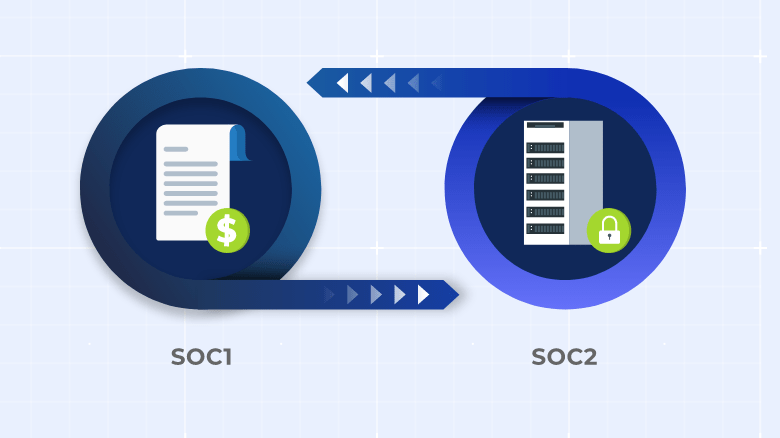In this article we will be diving deep about this interesting topic SOC Audit and Review.

Now, let us see what it means !
Introduction
Companies rely on service providers to streamline day-to-day operations and assure sustained functionality now more than ever. The rise of cloud computing, data centers, and software-as-a-service (SaaS) companies demonstrates this. However, there is considerable risk associated with these outsourced duties because of their ease and convenience.
The capacity to demonstrate the establishment and effective application of internal controls in respect to the services they provide is a crucial distinction between service providers and their rivals. A System and Organization Controls (SOC) audit is a simple way to provide this assurance to all important stakeholders.
Defining SOC Report
In a nutshell, a SOC report is issued after a third-party auditor performs a thorough assessment of a company to ensure that it has an effective system of controls in place for security, availability, processing integrity, confidentiality, and/or privacy. The report, which is produced by a Certified Public Accountant (CPA), gives reasonable assurance regarding the design and operation effectiveness of controls and clearly defines any potential risks for customers or partners considering doing business with the company.
There are a few key terms you should be aware with in order to comprehend SOC lingo:
– The service organization is the one that is being evaluated.
– The organization that outsources a function to a service organization is known as a user entity.
– Control is a verifiable procedure or system for preventing or detecting risk.
When it comes to obtaining the trust of other organizations and their stakeholders, such as vendor compliance, internal audit, IT management, and legal departments, transparency is critical. The success or failure of specific controls has a substantial impact on the service organization’s reputation, financial statements, and stability.
Now, let us see the types of SOC reports
Types Of SOC Reports
The nature and scope of SOC reports vary widely due to the varying controls of various service organizations and the types of services they provide. The American Institute of CPAs (AICPA) describes the several forms of SOC reports, including SOC for Cybersecurity and SOC for Supply Chains, which is currently in development. The most often issued reports, however, are SOC 1 and SOC 2.
SOC 1
The SOC 1 report examines a service organization’s business processes and information technology controls that could affect the financial statements of a user entity. Internal controls over financial reporting is the term for this (ICFR). Controls can be as simple as requiring complex passwords for all systems and restricting access to authorized users, or as complicated as penetration testing, which examines system weaknesses. Payroll processing, medical claims processing, and loan servicing companies are examples of service corporations that would earn a SOC 1 rating.
The level to which the controls must be assessed to establish acceptable user entity assurance differs between the two types of SOC 1 reports.
– Type I – also known as point-in-time reports, these audits assess controls as of a given date and include a description of the service provider’s system. Type I reports examine just the design of a service organization’s controls, not their efficacy in operation. The majority of organizations obtain a Type I report only once before moving on to a Type II report.
– Type II – this report covers a specific time period (usually 12 months), provides a description of the service organization’s system, and assesses the controls’ design and operational effectiveness.
Regardless of the type of SOC 1 report a service organization requires, it’s critical for management to plan the auditing process ahead of time to ensure adequate coverage for the fiscal year in which user entities operate.
SOC 1 : Structure
The report consists of 5 major sections.
– Opinion letter: Depending on the type of audit and the opinion being delivered, this is where the auditor will define the scope of the report, report as-of-date (Type I) or test period (Type II).
– Assertion of management : This section contains management statements such as an assertion that the system’s description accurately reflects the system, that the control objectives were suitably designed (Type I) or suitably designed and operating effectively (Type II), and an explanation of the criteria used to make the assertion.
– System Description :This section discusses the supporting processes, policies, procedures, personnel, and operational activities that make up the service organization’s service and may have an impact on the ICFR of the user entity.
– Test Control and Results of Testing : The auditor will describe the controls that were tested, the processes used to test the controls, and the results of the testing in this section.
– Miscellaneous Information : This part is not generally included, although it is occasionally included to provide extra information that the auditor’s conclusion does not cover.
SOC 2
While the SOC 1 report focuses on financial reporting internal controls, the SOC 2 report focuses on non-financial controls. Organizational supervision, vendor management programs, risk management processes, and regulatory oversight all benefit from SOC 2 reports. The SOC 2 report’s non-financial controls are organized into five Trust Services Categories (TSC):
– Security : Unauthorized physical and logical access to information and systems is prevented, which could jeopardize the entity’s capacity to achieve its goals.
– Availability :As promised or agreed, information and systems are ready for operation and use.
– Integrity : The processing of information and systems is comprehensive, accurate, timely, and authorized.
– Confidentiality : To satisfy the user entity’s goals, information that has been marked as confidential is protected.
– Privacy : Personal data is collected, used, maintained, disclosed, and destroyed in accordance with the privacy notice of the user entity.
The SOC 2 report has the same structure as the SOC 1 report and can be classified as Type I or Type II depending on whether or not the control design and effectiveness need to be assessed. In addition, for service firms to partner with tier-one organizations in the supply chain, a SOC 2 report is sometimes required. Data centers, SaaS, and network monitoring service providers are examples of the types of service firms that might earn a SOC 2 report.
Understanding Auditor’s Opinion
You will receive a report stating the auditor’s opinion once the testing process is completed, albeit the language of these reports can be difficult to grasp. It’s critical to read the report thoroughly and comprehend the many types of opinions, paying special attention to the service organization’s controls that could have an impact on your company’s security.
– Controls were designed effectively (Type I) or designed and functioning effectively (Type II) to fulfil the specified control objectives (SOC 1) or TSC (unqualified opinion)(SOC 2).
– Qualified Opinion – The auditor is unable to provide an unqualified conclusion, but the qualified findings do not support an unfavorable opinion. One or more control goals (SOC 1) or TSC (SOC 2) were not met in a satisfactory manner.
– Adverse Opinion – Testing exceptions are many and widespread, and controls are often ineffectively conceived and/or implemented.
– Disclaimer Opinion – The auditor is unable to provide an official opinion since they were unable to acquire the necessary evidence to form one.
Receiving an unqualified opinion is the optimum outcome for both the user entity and the service business. Any report that ends with a different sort of opinion should be investigated further and treated with caution by the user entity.
SOC reporting is a comprehensive, repeatable reporting procedure that aids in the development of trust and transparency between service organizations and user entity stakeholders. Businesses may ensure that contractual commitments are met while decreasing upfront compliance expenses by proactively identifying and mitigating risk.
Our expert team at K Financial can assist you if your firm is having trouble providing assurance around risk management and controls.
Conclusion
That’s all about the SOC Audit and Review. After reading this essay, I hope you found it enjoyable and learned something new. We have learned what are SOC audits, reviews, reports, structure and types of their reports.

